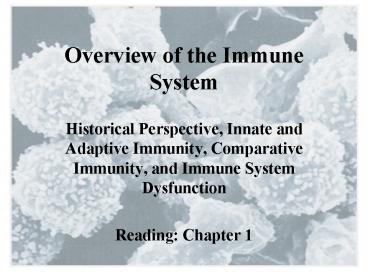Overview of the Immune System - PowerPoint PPT Presentation
1 / 29
Title:
Overview of the Immune System
Description:
Defense system evolved to protect against infectious agents and cancerous cells ... Niels Jerne, David Talmadge, F MacFarlane Burnet ... – PowerPoint PPT presentation
Number of Views:64
Avg rating:3.0/5.0
Title: Overview of the Immune System
1
Overview of the Immune System
- Historical Perspective, Innate and Adaptive
Immunity, Comparative Immunity, and Immune System
Dysfunction - Reading Chapter 1
2
- Introduction to the Immune System
- Defense system evolved to protect against
infectious agents and cancerous cells - Functional activities of the Immune System
- Recognition
- Response
- Effector
- Memory
- Arms of the Immune System
- Innate/Natural
- Adaptive/Acquired
3
- Historical Perspective
- Early accounts of disease and pestilence
- Thucydides and the term immunity
- Early attempts to induce immunity
- 15th Century Chinese and Turks develop
variolation - Edward Jenner, 1798
- Louis Pasteur (1870s)- the beginning of
Immunology as a discipline and origins of the
term vaccine - First human vaccination (1885) attenuated rabis
virus
4
Identification of the Two Arms of the Immune
System
- 1883 Metchnikoff and Ehrlich demonstrate
Cell-Mediated Immunity - First evidence of cellular phagocytosis
- 1890 Behring and Kitasato demonstrate Humoral
Immunity - Demonstrated that the noncellular component of
blood could transfer immunity to diptheria from
one organism to another - The great debate cellular or humoral immunity
- Supporters gather evidence, ex.
- Bruce Glick and identification of T and B
lymphocytes - Elvin Kabat and identification of antibodies in
serum - Demonstration of autoimmune disease and
contradiction of Ehrlichs horror autotaxicus
5
Two Theories on the Mechanism of Specificity of
the Immune System
- Selective Theory
- Paul Ehrlich (1900) side- chain receptors and
the lock and key mechanism specificity is
predetermined - Porter and Eldeman (1972) determined antibody
structure (receptors are both soluble and
membrane bound) - Instructional Theory
- Linus Pauling, Friedrich Breinl and Felix
Harwrowitz (1930s and 1940s) Antigen is
important for determining specificity of the
antibody (disproved)
6
Modern Theory of Specificity
- Clonal-Selection Theory
- Underlying paradigm of modern immunology
- Niels Jerne, David Talmadge, F MacFarlane Burnet
- An individual lymphocyte expresses a membrane
receptor specific for a distinct antigen - Receptor specificity is determined before
lymphocyte is exposed to the antigen - Binding of antigen to the receptor activates the
lymphocyte causing it to proliferate into a clone
of cells with similar immunologic specificity
7
(No Transcript)
8
- Innate and Adaptive Immunity
9
Innate Immunity
- First defense against infection
- Components present before infection
- Mechanism of protection is not specific for
infectious agent - Important components and types of defensive
barriers
10
- Innate Immunity and its defensive barriers
- Types of barriers
- Anatomical Physiologic Phagocytic Inflammatory
- Anatomical barriers and the prevention of entry
- Skin
- Epidermis
- Dermis
11
- Skin
- Dermis
- Connective tissue, blood vessels, hair follicles,
sebaceous glands, sweat glands - Sebaceous glands and the production of sebum
- Lactic acid and fatty acid
- Maintenance of acidic pH of skin
- Vulnerability of skin as a barrier
12
- Innate Immunity
- Anatomical barriers
- Mucous membranes
13
(No Transcript)
14
- Toll and Toll-like receptors (TLRs)
- Function
- Identification
- Examples
- TLR2
- TLR4
- TLR3
- Limited specificity of the innate immune system
15
- Phagocytic Barriers
- Phagocytosis
- Cell types
- Monocytes, neutrophils, tissue macrophages
- Phagocytic process
16
- Phagocytosis
17
- Inflammatory barriers
- Five Characteristic signs
- Redness, swelling, heat, pain, loss of function
- Causative events
- Vasodilation, increased capillary permeability,
emigration of phagocytes - Role of chemical mediators
18
Adaptive Immunity
- Characteristic Features
- Antigenic specificity
- Diversity
- Immunologic memory
- Self/non-self recognition
19
- Humoral and Cellular branches of Adaptive
(Specific) Immunity - Antigen Recognition by Lymphocytes
- WBCs produced in the bone marrow
- Circulate in blood and lymph
- Reside in lymph nodes
- Produce and display receptors that recognize
foreign particles
20
- Functional Cell Types of Adaptive Immunity
- Lymphocytes
- B Lymphocytes
- Memory and Plasma B cells
- T Lymphocytes
- T helper (TH) and T cytotoxic (TC) cells
- Expression of membrane associated proteins CD4
and CD8 - Antigen Presenting Cells
- Macrophages
- Lymphocytes
- Dendritic cells
21
- Major Histocompatibility Complex (MHC)
- Large genetic complex with multiple loci encoding
membrane bound glycoproteins - Class I and Class II MHC molecules
- Recognition by CD8 and CD4 cells
- Presentation of antigenic peptides to T
lymphocytes
22
- Antigen-presenting cells (APC)
- Function- internalize antigen by phagocytosis or
endocytosis and display antigenic peptide on MHC - Express co-stimulatory molecules to activate T
cells - Cell types
- Macrophages, lymphocytes, dendritic cells
23
Exogenous
Endogenous
- MHC molecules and the processing of antigens
- Antigen presentation to T lymphocytes
- Exogenous foreign particle endocytosis or
phagocytosis Class II MHC CD4 T helper
cells - Endogenous foreign particle degraded into
peptides Class I MHC CD8 T cytotoxic
cells
24
(No Transcript)
25
- Antigen selection and clonal expansion
26
- Humoral Response
- Immunologic memory
- First exposure Primary response lag of
5-7 days and peaks at 10-17 days while TH cells
activate B cells - Second exposure Induction of a rapid response
lag of 1-2 days lasts months to years due to
clonal expansion and activation of memory B cells
27
- Cell-mediated immune response
- Collaboration of innate and adaptive immune
responses yields strong defense against infection
(Table 1.3)
28
Innate and Adaptive Immunity
29
- Immune Dysfunction































